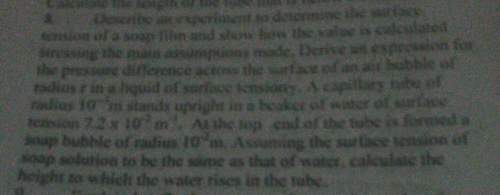
Physics, 30.07.2019 04:10 latraviacox12
In 1970, russian scientists began drilling a very deep bore- hole in the kola peninsula. their goal was to reach a depth of 15 kilometers, but high temperatures in the borehole forced them to stop in 1994 after reaching a depth of 12 kilometers. they found that below 3 kilometers the temperature t increased 2.5°c for each additional 100 meters of depth. (a) if the temperature at 3 kilometers is 30°c and x is the depth of the hole in kilometers, write an equation using x that will give the temperature t in the hole at any depth beyond 3 kilometers. (b) what would the temperature be at 12 kilometers? (c) at what depth (in kilometers) would they reach a tempera- ture of 200°c?

Answers: 1


Another question on Physics

Physics, 22.06.2019 06:00
Explain earth's motion, using the terms "precession" and "rotation" in your answer.
Answers: 1

Physics, 22.06.2019 09:00
When a bicycle coasts uphill, it moves slower and slower as it climbs. why? a. its kinetic energy is transforming into heat energy. b. its potential energy is transforming into kinetic energy. c. its kinetic energy is transforming into potential energy and heat energy. d. its potential energy is transforming into kinetic energy and heat energy.
Answers: 1

Physics, 22.06.2019 16:50
Acommercial refrigerator with refrigerant-134a as the working fluid is used to keep the refrigerated space at -35°c by rejecting waste heat to cooling water that enters the condenser at 18°c at a rate of 0.25 kg/s and leaves at 26°c. the refrigerant enters the condenser at 1.2 mpa and 50°c. if the compressor consumes 3.3 kw of power, determine (a) the mass flow rate of the refrigerant, (b) the refrigeration load, (c) the cop, and (d) the minimum power input to the compressor for the same refrigeration load.
Answers: 2

Physics, 22.06.2019 18:30
Ben (55kg) is standing on very slippery ice when junior (25kg) bumps into him. junior was moving at a speed of 8 m/s before the collision and ben and junior embrace after the collision. find the speed of ben and junior as they move across the ice after the collision. give the answer in m/s. describe the work you did to get the answer.
Answers: 1
You know the right answer?
In 1970, russian scientists began drilling a very deep bore- hole in the kola peninsula. their goal...
Questions


Advanced Placement (AP), 05.09.2020 23:01


Mathematics, 05.09.2020 23:01


Physics, 05.09.2020 23:01






Chemistry, 05.09.2020 23:01

Geography, 05.09.2020 23:01

Mathematics, 05.09.2020 23:01

Mathematics, 05.09.2020 23:01



Mathematics, 05.09.2020 23:01





